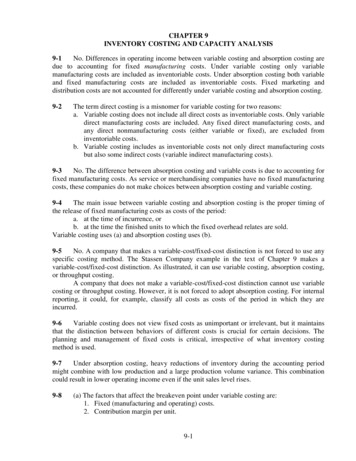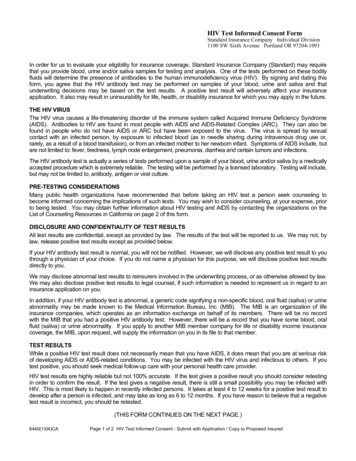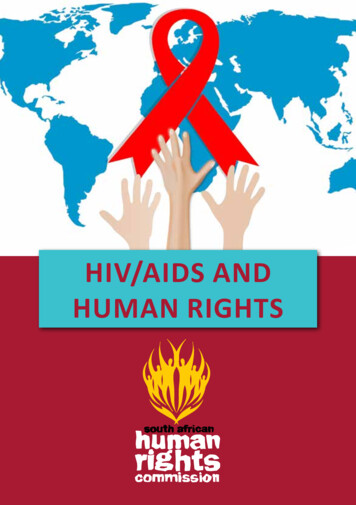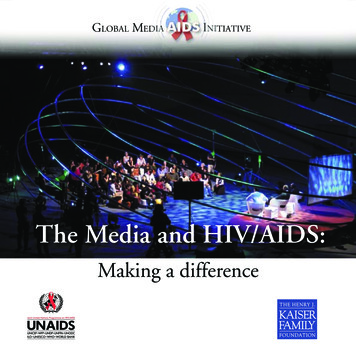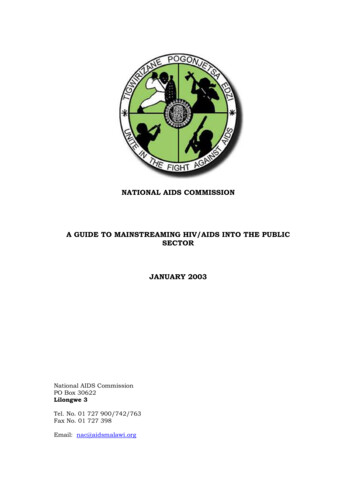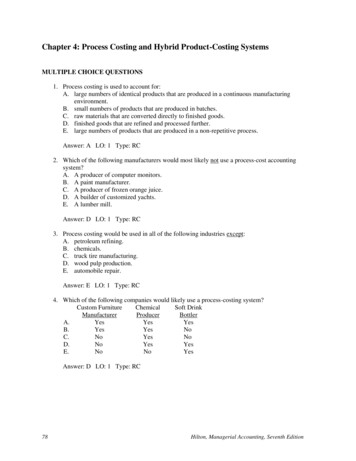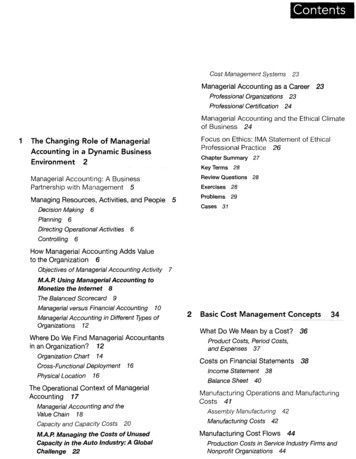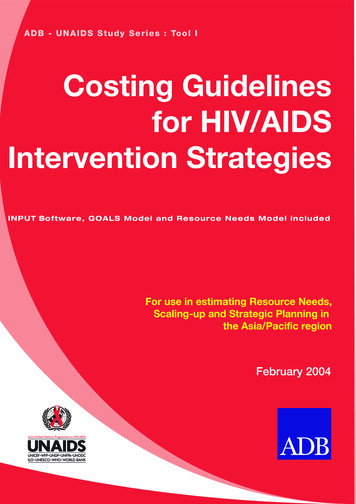
Transcription
ADB - UNAIDS Study Series : Tool ICosting Guidelinesfor HIV/AIDSIntervention StrategiesFor use in estimating Resource Needs,Scaling-up and Strategic Planning inthe Asia/Pacific regionFebruary 2004
This document is a collaborative work of the Asian Development Bank, UNAIDS, Futures GroupInternational and Ease International and forms a part of the training material used to cost prevention and care activities at local, country and regional level. Contributors (in alphabetical order): Anita Alban, Michael Hahn, Catherine Hankins, Sigit Priohutomo, Myat Htoo Razak, DCSReddy, Swarup Sarkar and John Stover. The primary spreadsheet INPUT for Nepal was produced by Anita Alban and Michael Hahn; the regional version was developed by Vidya Ganesh,DCS Reddy and Shyam Sundar, editing and review by Adriana Gomez, Michael Hahn, TonyLisle, Rebecca Moss, Lee-Nah Hsu, Rober Greenner and Swarup Sarkar. Views expressed inthis document do not necessarily reflect the official position of UNAIDS and Asian DevelopmentBank.UNAIDS/04.41E (English, original, February 2004)ISBN 974-91970-6-2First Edition, February 2004 Joint United Nations Programme on HIV/AIDS (UNAIDS) & Asian Development Bank(ADB), 2004All rights reserved. This document, which is not a formal publication of UNAIDS and ADB, maybe freely reviewed, quoted, reproduced or translated, in part or full, provided the source isacknowledged. The document may not be sold or used in conjunction with commercial purposes without prior written approval of UNAIDS or ADB (please contact the UNAIDS InformationCentre, UNAIDS, Geneva or ADB, Manila). The views expressed in documents by named authors are the sole responsibility of those authors.The designations employed and the presentation of the material in this work do not imply theexpression of any opinion whatsoever on the part of UNAIDS or ADB concerning the legal statusof any country, testimony, city or area or of its authorities, or concerning the delimitation of itsfrontiers and boundaries.The mention of specific organisations, companies or of certain manufacturer’s products doesnot imply endorsement or recommendation by UNAIDS or ADB in preference to others of asimilar nature that are not mentioned. Errors and omissions excepted, the names of proprietaryproducts are distinguished by initial capital letters.UNAIDS Information Centre, 20 AvenueAppia CH-1211 Geneva 27 SwitzerlandTel: 4122-791-3666Fax 4122-791-4187E-mail: unaids@unaids.orgInternet: http://www.unaids.orgAsian Development Bank6 ADB Avennue, Mendaluyong CityPO: Box 7890980 Manila, Philippineshttp://www.adb.org
FOREWORDOver half of the world’s population live in Asia and the Pacific. With widespread evidence of riskbehaviors and of situations that increase their vulnerability to HIV/AIDS, the potential for a significant worsening of the epidemic in the region is unmistakable. Furthermore[O1], most of theinterventions have achieved very low coverage or have been limited to implementation at projectlevels.The major barrier for scaling up is resources, both financial and human. Even when sufficientresources are available, they are not optimally used. This document provides guidelines for theprioritization and strategic allocation of resources as well as helping with developing local costestimates for appropriate activities that are of particular relevance to Asia-Pacific, Middle Eastern and North African countries. It provides simple tools for program managers, planners andproject directors to generate local costing figures based on local data.The document complements global tools developed by other groups, like Resources NeedModel and GOALS.[O2] This tool is a result of several years of work and is based on experiences from Bangladesh, India and Nepal and has been field tested in Indonesia. It builds uponthe hard work of NGOs, program managers, and health planners. The tool has been successfully used for large-scale resource mobilization, to develop national strategic plans, and for financial guidelines and preparation of GFATM proposals. I believe the tool can assist in nationalstrategic planning and in particular for achieving key principles for the coordination of nationalAIDS responses - the 'Three Ones': One agreed HIV/AIDS framework, one national AIDS authority and one monitoring and evaluation system.We encourage countries to use this along with other tools. We would also appreciate feedbackto enable us to introduce further improvements, as required, and to develop other relevant toolsin coming years.Suman Mehta,Associate DirectorAsia Pacific and Middle East DivisionUNAIDS, Geneva
Costing Guidelinesfor HIV/AIDSIntervention StrategiesFor use in estimating Resource Needs,Scaling-up and Strategic Planning inthe Asia/Pacific regionFebruary 2004
CONTENTSIntroduction . 1I.Prioritising the target population(s) . 4II. Setting population-based targets . 7III. Choosing and designing intervention packages . 9IV. Computing the costs of interventions . 11V. Estimating the total resource needs based on the sizeof the population . 21VI. Examining the impact of the planned intervention on the . 24prevalence and incidence of HIV; re-allocate and re-examineAnnex . 28Other costing examplesCommon abbreviations
Costing Guidelines for HIV/AIDS Intervention StrategiesINTRODUCTIONThis booklet provides assistance and guidance to planners and programme managers at country level in costing selected HIV/AIDS interventions while staying focused on the overall goals to halt and reverse the epidemic. It provides the schemefor Rapid Costing Assessments (RCAs) including a spreadsheet (INPUT) for generating local data on unit costs.Most countries in the Asia/Pacific region have completed the initial stages of a strategic planning process and have developed a plan for a number of years. The nextstep is to develop an operational plan that translates strategic goals into specificpopulation-linked targets and interventions. In order to mobilise resources and to reprioritise targets and interventions, overall resource needs have to be estimated. Inorder to do this strategic and operational plans must be costed; only then can programme managers ensure that sufficient resources are available to reach a coveragenecessary to impact upon the epidemic. This often means re-prioritising interventions and/or re-thinking the efficacy and cost-effectiveness of such activities.These costing guidelines concentrate mainly on the process of developing unit costsfor strategic considerations and planning. The simple concept of staging the epidemic in order to prioritise sub-populations is introduced. Once the target population is decided upon and its size estimated, the coverage required can be assessed,and appropriate interventions for behaviour change and/or service delivery designed.These interventions are based on international best practice, which include costeffectiveness. The overall costing fig ures can be arrived at using unit costs. A simplespreadsheet tool, INPUT, is introduced to assist programme managers in computinglocal unit costs for a given set of interventions. The process used to arrive at unitcosts is the RCA, which estimates resource needs for specific sub-populations basedon defined interventions and population size targets. It compares local costs withthose documented in international literature, and uses local costs when inputtinginto other models.For a given set of programme targets the overall impact on HIV prevalence can thenbe calculated using the GOALS model (http://www.futuresgroup.com/goals model).The current and future estimates of HIV projections with the estimated disease burden are used in this model. These inputs are directly imported from the SPECTRUMsoftware that conventionally generates the estimates. Specific interventions can thenbe chosen for different sub-populations with projected coverage and known unitcosts. Once the above information is input, the GOALS model generates the HIVprevalence among the adult population. In cases where the goal to halt and/or reverse the epidemic is not achieved, interventions can be re-considered and re-entered in to the model until a decline in HIV prevalence is observed.1
Costing Guidelines for HIV/AIDS Intervention StrategiesHowever, for each intervention, realistic goals must be defined. Both the human andfinancial resources available should be considered. This booklet aims to assist in theestimation of overall financial resource needs for scaled-up, effective responses atlocal level to halt the spread of the HIV/AIDS epidemic[S3].These costing guidelines are aimed at programme managers and planners with orwithout a background of health economics or public health. The guidelines: describe considerations for targeting appropriate population groups: prioritisingthe target population(s) consider coverage issues for an effective large-scale response: setting coveragetargets for reaching a specific sub-population help to examine activities that need to be implemented: choosing and designingeffective intervention packages and activities for the target population(s) explain the use of spreadsheet(s) to compute the costs of interventions as unitcosts use primary (local unit costs) and secondary data sources on costs (in absence oflocal data) and sizes of sub-populations: estimating the total resource needs basedon the size of the population introduce different methods including use of the GOALS model for optimising thestrategic allocation of resources: examining the impact of the planned interventionon the prevalence and incidence of HIV; re-allocate and re-examine2
Costing Guidelines for HIV/AIDS Intervention StrategiesFigure 1. Step-by-step costing3
Costing Guidelines for HIV/AIDS Intervention StrategiesI. PRIORITISING THE TARGET POPULATION(S)In low-prevalence countries the HIV epidemic is mostly limited to high-risk populationssuch as injecting drug users (IDUs), sex workers (SWs) and men having sex withmen (MSM).1 These groups are often hard to reach and/or criminalised due to socialstigma, factors which add to their vulnerability. The interventions required and thecomplexities of reaching the groups differ, as do the costs. As the epidemic advances, it spreads to bridge populations (clients of SWs, partners of IDUs, migrant/mobile populations etc.) who continue its spread to the general population. As thevirus spreads from one group to another, the size and the composition of the population to be targeted for prevention and care changes, increasing the resources neededto address the epidemic effectively.Figure 2. Targeting the populationStaging the epidemicCountries are classified into three epidemiological categories by the risk characteristics of predominantly-affected population groups and their HIV prevalence (Table 1).These categories describe the epidemiological status of HIV in a country and helpplanners and programme managers to make strategic decisions.Table 1. Epidemiological categories14In some countries local epidemics have been triggered by nosocomial infections and unsafe blood products.
Costing Guidelines for HIV/AIDS Intervention StrategiesFigure 3. Patterns of HIV showing low and concentrated epidemics in majority Asia/Pacific countriesSource: UNAIDS July 2002, Report of the Global HIV/AIDS epidemicThe majority of countries in the Asia/Pacific region show low or concentrated levelsof the HIV epidemic on a national scale. Only Thailand and Cambodia are experiencing generalised epidemics. A national classification often masks the real picture atlocal level; an overall low-prevalence country may have concentrated and generalised epidemics in certain locations that need to be addressed accordingly. The aimof planners and programme managers in countries with low - or concentrated epidemics is to:- prevent a generalised epidemic- bring the prevalence below five percent in high-risk groups, and- maintain low levels of HIV among all sub-populationsThe intent in countries already experiencing generalised epidemics is to halt andreverse the spread.Which populations to target?Unfortunately, there is no standard answer to this much-debated question; a population is not a homogeneous group with uniform patterns of behaviour. It consists ofa number of small groups or sub-populations, each with its own culture, norms andbehavioural patterns. Accepting that in principle the whole population is at risk andthat there is no clear delineation between high-risk groups and the general population (e.g. SWs are part of the general population) the risk of being infected with HIVis higher for some sub-populations than for others. Due to limited resources, bothhuman and financial, the targeting of a population is a crucial strategic decision.As the HIV epidemic follows a predictable path - from high-risk/vulnerable groups(sub-groups with a higher risk of HIV infection) via bridge populations to the generalpopulation (the group with relatively lower risk of HIV infection) interventions andtargeted sub-populations will vary. Focusing interventions on recognised risk/vulnerable groups, before HIV gains a strong foothold, prevents and slows down the spreadof the epidemic.2 Interventions should aim to cover all high-risk groups in order tocontain the spread to groups at relatively lower risk, i.e. the general population.2Although sub-populations are focused on here, certain basic interventions (e.g. policy, safe blood supply, surveillance, raising of awarenessand training of health personnel etc) should also be planned, costed and implemented even in the early stages of the epidemic.5
Costing Guidelines for HIV/AIDS Intervention StrategiesTable 2. Population sub-groups and programme goalsStage of the epidemicPrevalence inaffected groupsProgramme goalsAffected populationsub-groupsLow 5%Halt progress of epidemic,keep it 5% among thesegroupsIDUs/SWs/MSMConcentrated 5%, but 1% in antenatalwomenHalt and reverse progress,bring it to 5% amongthese groupsIDUs/SWs/MSM, clientsof SWs, migrant/mobilepopulations, uniformedservices and partners ofabove populationsGeneralised 1% in antenatal womenHalt and reverse progress,bring it to 1% among antenatal womenGeneral population,young peopleSource: UNAIDS. 2001. Based on "Effective prevention strategies in low HIV prevalence settings", Arlington: Family Health International.6
Costing Guidelines for HIV/AIDS Intervention StrategiesII. SETTING POPULATION-BASED TARGETSSetting targets for prevention coverageCoverage is critical element when attempting to make an impact on the epidemic.Like other communicable diseases, HIV does not show a decline in incidence (newinfections) unless a critical mass of people change their behaviour. In other diseasesthis behaviour change may mean completed immunisation or use of safe water; inthe case of HIV/AIDS it means safe sexual behaviour and for IDUs either no injecting,or safe injecting among other changes.A wider population needs to be reached with effective behaviour change interventions, as not all of those targeted will change their behaviour. Unfortunately there isno standard ratio of people reached, to people who change their behaviour. Also,the effect of behaviour change intervention varies widely in intensity, effort and quality and is not as consistent as drug or vaccine interventions.Although the question of how many people need to change their behaviour before animpact on the epidemic is significant, for planning and costing purposes the reach ismore important. In order to trigger behaviour change, as many people as possibleneed to be reached in a specific population sub-group with quality interventions. Therefore, initially total coverage (reach) and behaviour change of an entire population willbe planned for. Later, when a more detailed picture is available as to the percentage ofthe sub-population reached actually changes their behaviour, the planning figures canbe adapted accordingly. When planners are faced with resource constraints (bothhuman resources as regards implementation capacity, and/or financial resources) programmes should be phased in with increasing levels of coverage. For planning purposes this means that the target being planned and costed for should be 80-100percent of the sub-population in which behaviour change should occur.The normative approach, based on data shown in Fig. 4a (next page), is another practice for setting targets. India, and the former CIS countries3,4 have used a 60 percentbehaviour change outcome for IDU and/or SW intervention for planning or costingpurposes. This is based on historical data including Cambodia among others wherepre-intervention HIV prevalence among SWs was 42-57 percent. This figure started todecline once those adopting safe sexual behaviour (consistent condom use amongSWs) exceeded 50 percent of the population. Still, for costing purposes the reach hadto be calculated, which was 10-20 percent higher than the behaviour change target.Modelling (see Fig. 4b next page) can also be used to determine the critical mass(target for coverage). Reliable historical data on coverage and incidence or prevalence (if available) can be plotted to identify critical coverage levels. If prevalencedata are available the incidence can be estimated with SPECTRUM. Alternatively,these can be worked out using tools: e.g. HIV Tools developed by the London Schoolof Hygiene and Tropical Medicine (http://www.hivtools.lshtm.ac.uk). However it ispreferable to use local data in this model; if local data is not available, results fromother sites may be used.In Bangladesh it was found that HIV prevalence among SWs could be maintainedbelow five percent (from a baseline of less than one percent) if behaviour change(consistent condom use) was achieved among two thirds of the group.5 While setting targets, planners and programme managers should remember that maintainingprevalence below five percent in high-risk groups is the overall goal of HIV/AIDSintervention programmes.3World Bank.2000. The Project Appraisal Document for India. Washington DC: World Bank.DFID.2000.Strategic Plan for Former CIS Countries. London: DFID5Samsuddin A K M. 2000 Towards an expanded HIV/AIDS Response in Bangladesh-Protecting the Future. Presentation at NationalStrategic Planning Meeting. Dhaka by Dr. A.K.M. Shamsuddin, Programme Manager, National AIDS/STD Prog. Deputy Dir., PHC, Govt ofBangladesh May 200047
Costing Guidelines for HIV/AIDS Intervention StrategiesFigure 4a. BSS and HIV sero-surveillance data, Cambodia demonstrating a clear correlationbetween behaviour change and the decline of 01YearSource: Based on NCHADS. 2002. HIV Sentinel Surveillance: Presentation by Dr Tia Phalla at the disemmination meeting of HIV surveillancedata for 2002, held at Phnom Penh, Sept 2002.Figure 4b. Modelling example showing HIV remaining 5% with consistent condom use of 67%(2/3rd coverage)Sex worker withoutinterventionSex worker afterinterventionClient withoutinterventionClient afterinterventionSource: Dr. Samsuddin, National AIDS Programme Manager, Bangladesh 2000: Presentation at National Strategic Planning Meeting, Dhaka.8
Costing Guidelines for HIV/AIDS Intervention StrategiesIII. CHOOSING AND DESIGNING INTERVENTION PACKAGESIn order to achieve specific outcomes, sets of activities need to be implemented. Inthese sets of activities are often either behaviour change, access to quality serviceslike sexually-transmitted disease (STD) treatment and voluntary counseling and testing (VCT), or raising awareness to a certain level, e.g. correct knowledge about HIV/AIDS. These packages can be designed for different sub-populations and/or outcomes, and must be costed.This approach allows for the design and costing of prevention intervention packagesfor any sub-populations (e.g. SWs, IDUs, migrant/mobile populations or young people) or delivering care services like ART or PMTCT etc. Usually, the activities in aspecific intervention package can be grouped around five main elements:1. Behaviour change communication (including outreach and peer-outreach activities6)2. Delivery of tools (commodities) and services for prevention (needles and syringes and drug substitution for IDUs, distribution of lubricants and condomsand treatment of STDs for specific sub-populations) and care (testing,counseling, ART, treatment of OIs)3. Creation of an enabling environment at project level4. Programme management5. Monitoring and evaluation at project levelExamples of activities for each of these elements are presented in detail in Table 3,p12. A specific outcome often requires different intervention packages for a numberof sub-populations, and as the costs of activities vary, the costs of a specific outcome often vary for different groups; e.g. the costs of facility-based STD services forthe general population may be completely different to the costs of delivering STDservices for marginalised sub-populations like SWs or the MSM population. BecauseSWs and the MSM population are marginalised, they may not attend clinics for thegeneral population; separate clinics may have to be established to cater for theirneeds. Therefore, when assessing the resource needs in prevention and care interventions, cost considerations relevant to the target populations should be taken intoaccount.An alternative approach is to cost the activities directly, irrespective of the sub-population they are targeted at. Costs pertaining to population-specific additional inputs(e.g. costs accruing on account of multiple visits by a peer-educator [PE] to educateat the beneficiary’s convenience) are overlooked when this approach is used. A list ofdirectly costed activities used in the Resource Needs model and the GOALS modelis given on page 21. Interventions can be identified and adopted from this list forcosting sub-population-specific programmes, with due corrections for sub-population specific additional inputs.6When services or awareness campaigns are delivered and carried out outside institutional settings, such as clinics and educationalinstitutions, they are called ‘outreach’ activities. These activities need to be undertaken at beneficiaries’ convenience. A ‘peer’ is a personfrom the same group or category as another; therefore, a sex worker (SW) may work as a ‘peer’ educator (PE) for SW-intervention and astudent as a PE for another student. Peer norms and peer pressure are the most influential vehicles for behaviour change.9
Costing Guidelines for HIV/AIDS Intervention StrategiesInterventions are discussed for prevention of HIV/AIDS among the followingsub-populations: Sex workers Injecting drug users- Needle/syringe programmes- Oral substitution MSM (Men who have sex with men) Oral substitution for IDUs STI / VCT clinics for mobile populations and their families Young people (life skills and awareness programmes)Interventions related to care are discussed for the following: Voluntary counseling and testing (VCT)7 Mother-to-child transmission (MTCT)7 Care and Support (includes the following) Palliative care Opportunistic infection (OI) treatment TB treatment8 OI prophylaxis HAART, including laboratory monitoringEach of the above interventions has several sub-activities, which need to be considered when costing. A list of sub-activities for each intervention is provided in theAnnex, p25-37. Interventions to alleviate impact like programs for orphans are notdiscussed in this manual and a snapshot of costing of useful and essential interventions (policy, blood safety, military and police, mass media) is captured in a workbook named 'other interventions' in the INPUT spreadsheet.7VCT and PMTCT are undoubtedly effective prevention interventions. However, in this document, these are discussed under care becauseboth need finally referral to care and support systems.8Although TB is an OI, it is listed as a separate item because it is the most common OI in the Asia/Pacific region.10
Costing Guidelines for HIV/AIDS Intervention StrategiesIV. COMPUTING THE COSTS OF INTERVENTIONSThis is simple provided some general principles are applied. The following paragraphs list and explain the most important ones.Unit costingUnit costs are the total costs divided by the output measure. For example if US 100,000 are spent in one year on SW-interventions and 1,000 SWs are reachedwith these interventions, the unit costs are US 100 (per SW, per year). The outputmeasures can be the number of people reached, condoms distributed, patientstreated etc. Unit costing tries to estimate the costs needed per intervention and is forplanning purposes only. Unit costs are average figures, including assumptions ofcoverage and cannot replace a project budget; but for resource need estimation andallocation purposes they are accurate and easy to compute.Economic costing vs. programme costingEconomic costing tries to cover all cost elements including the costs of free items.Programme costing covers only those costs that are met by the programme. Ineconomic terms free items do not exist, as everything has a price; e.g. in economiccostings, the full price for condoms would be included, even if the condoms areprovided free to the programme because somebody pays for them. Airtime costswould also be included in full economic costings. Although in actual terms the airtime may be provided free, it still has a price. This is especially important whencomparing unit costs of specific interventions; be careful not to compare full economic unit costs with programme costs. Unfortunately the method often used forcosting is not part of the information on unit costs, which makes the two very difficultto compare. The method used here and in the following models is economic costing.Costing intervention packagesNormally, single activities do not exist. Even a straightforward activity like handingout a leaflet in the street, is composed of a set of activities and cost elements (salaries, printing, transport etc.). More complex interventions like delivery of HAART require a larger sub-set of activities to be carried out as well as essential resources inorder to achieve behaviour change (e.g. training, supervision, salaries, addressingstigma and discrimination) and quality of services (e.g. ensuring proper adherenceto drug regimens, and necessary support systems). Planners and programme managers must ask what is needed for behaviour change among SWs for example. Theanswers then form the critical elements of the intervention and can be costed easily:e.g. peer-educators (PEs) for outreach, supervisors, condoms, STI services, an enabling environment at local level, training materials, programme management etc.The costs of behaviour change among SWs can then be estimated. The followingpages list examples of such packages that have been used in different countries inthe Asia/Pacific region, and a simple spreadsheet for calculating unit costs.99These are not fixed guidelines or normative packages. In each country the necessary interventions and the INPUT spreadsheet aredeveloped to fit local needs and resources. INPUT can be modified to local needs easily without the need for IT specialists.11
Costing Guidelines for HIV/AIDS Intervention StrategiesUsing the INPUT spreadsheet to estimate unit costsThe INPUT spreadsheet calculates unit costs for common HIV/AIDS interventions,using the prevailing local costs in a particular country. Its purpose is to generaterelevant and realistic unit costs for use in costing national plans. It is based on country-level experiences in the Asia/Pacific region and has been successfully used incosting HIV/AIDS plans by a number of countries in the region. INPUT is a workbookwith several worksheets: the first three sheets contain information on local currencyand its US dollar equivalent; converge target and summary of resource needs; theremaining nine sheets are designed to calculate unit costs for each individual interventions. They deal with both prevention and care and support .Under the section on prevention there are six intervention modules covering SWs,MSM, IDUs (harm reduction and oral substitution), migrant and mobile populationsand young people (including life skills development and awareness generation). Mostof these modules build on five mentioned essential elements: behaviour change communication (BCC), prevention tools and supplies, enabling environment, programmemanagement including capital investments, and monitoring and evaluation (M&E).Behaviour change interventions are based on peer-outreach strategies. The underlying assumption is that behaviour change is more than mere awareness and requires reinforcement of a message by repeated interaction through peer-outreachnetworks, group education (IEC/events), availability of prevention tools (commodities) and easy access to services. If availability of prevention tools (e.g. condoms,lubricants, needles and syringes) or access to services (e.g. treatment of STDs for allrisk populations) and substitution therapy (e.g. methadone and Buprenophine forIDUs) is poor, awareness rarely leads to behaviour change.10In the absence of a supportive environment, the target population may not acceptthe services offered. Also local people may be hostile to
nancial guidelines and preparation of GFATM proposals. I believe the tool can assist in national strategic planning and in particular for achieving key principles for the coordination of national AIDS responses - the 'Three Ones': One agreed HIV/AIDS framework, one national AIDS au-thority and one monitoring and evaluation system.
